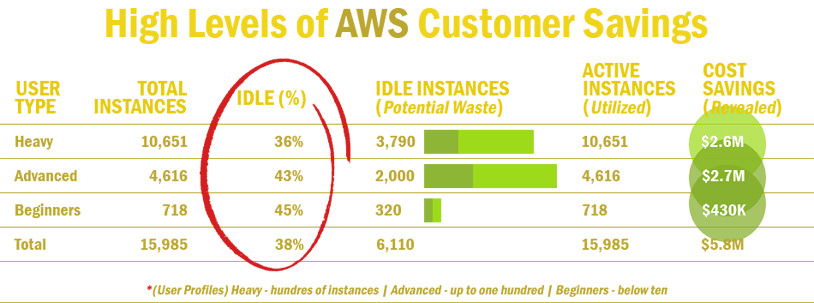2024 © TechOnsite All Rights Reserved
Amazon Web Services
Home › Amazon Web Services Admin
Getting Started With Amazon Web Services
Amazon Web Services or AWS is the biggest player in the cloud computing market today. It is a suite of cloud-based, pay-as-you-go resources and services that you can use in building web applications by providing the primary infrastructure components with minimal support and administration costs. It provides more reliability, scalability and flexibility in deploying web-scale solutions than the traditional data centers.
Below is a simple analysis that represents an opportunity for AWS customers to increase the efficiency of their infrastructure systems and save.


AWS Service Offerings


Amazon EC2
The reliable cloud instance service with SSD support and snapshot backup. Elastic Load Balancer : High performance Elastic Load Balancer. Auto Scaling : Spawn pre-defined EC2 instance automatically when traffic increased.
Amazon WorkSpace
Cloud Virtual Desktop with built-in office application.
Amazon VPC
Cloud Private Network with VPN connection to office and data center.
Amazon Route 53
High performance DNS with fail-over and load balancing.
Amazon CloudFront
Static Content Delivery Service with thousands nodes all over the world with low latency, high data transfer speeds, and no commitments.
Amazon Glacier
Low-Cost secure storage service, specially good for archiving and Backup.
Amazon S3
Secure, Redundant, Fast Cloud Storage.
Amazon RDS
Memory Optimized DB Instances with better performance at lower cost; support MySQL, Oracle and PostgresDB. Reliable DB operation; automated DB backup, snapshot, Multi-AZ.
Amazon DynamoDB
Fast, fully managed NoSQL Database service with built-in fault tolerance. Fully distributed, shared architecture.
Amazon ElastiCache
Improve performance by fast managed, in-memory caches either by memcache or redis.
Amazon EMR
Web service that makes it easy to quickly and cost-effectively process vast amounts of data. Using Hadoop, Amazon EMR is used in a variety of applications, including log analysis, web indexing, data warehousing, machine learning, financial analysis, scientific simulation, and bioinformatics.
“It had been a while since I had an expert service my computer so I decided to schedule an on site visit and evaluation… These guys are knowledgeable, honest, have great attitudes and their rates are very fair.”
Don W. Santa Monica, CA
“Techonsite has been very helpful with the IT issues in our dental office. J came out and made sure our network was working smoothly. Later when we had another issue he quickly resolved it via the internet and he didn't even charge us for it! I would highly recommend Techonsite for anyone's tech needs.”
Josh P.Palms, Los Angeles, CA
“Could not be more pleased with our service! Our office has been having network issues for months, and we've had people come in and charge us ridiculous amounts of money with no improvement. Techonsite fixed our network in only a couple hours, and was very reasonably priced! I would 100% recommend them.”
Kaitlyn L.Westlake Village, CA
“Techonsite could not have been more professional or qualified to help our startup get things up and running! We had some VOIP and server issues, and they got us on the right track before we knew it! HIGHLY RECOMMEND to anyone looking for onsite help on the west side. Thanks Techonsite! You guys are the best :)”
Connor M.Los Angeles, CA
“We've been using Techonsite for years. I think we were one of their first accounts. They have done a superior job keeping our systems running smooth. They are very good and very professional. They've handled all of our server upgrades and integration of new hardware & software systems.”
Cyndi N.Lake Forest, CA
"Techonsite provides excellent service! They are very responsive and they really pay attention to their customers. I would recommend their service to anyone!"
Melanie L.Culver City, CA
"I'm a serious customer! I don't have time for small talk either, so when I say I'm thankful for J at Techonsite, I couldn't be more serious. Techonsite is prompt and dependable. My business depends on their service and they deliver!"
Lisa H.Glendale, CA


Small Business IT Support & Computer Services
Most businesses start with an idea and develop over time. Big businesses were once small. We understand the dynamic nature of running a small business and the constant ‘pull and push’ of keeping things running smoothly. We are here to make your lives easier so you can work ‘on’ your business and not ‘in’ it. Let technology streamline your processes and do more with less.